
A locomotive or engine is a rail transport vehicle that provides the motive power for a train. If a locomotive is capable of carrying a payload, it is usually rather referred to as a multiple unit, motor coach, railcar or power car; the use of these self-propelled vehicles is increasingly common for passenger trains, but rare for freight trains.
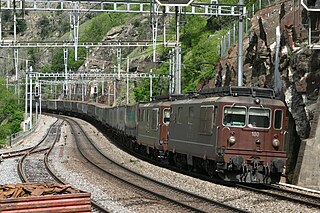
The Bern-Lötschberg-Simplon-Bahn (BLS), known between 1997 and 2006 as the BLS Lötschbergbahn, was a Swiss railway company. In 2006 the company merged with Regionalverkehr Mittelland AG to form a new company called BLS AG.
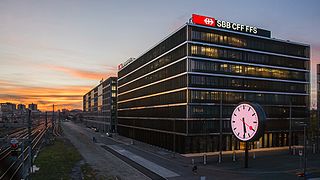
Swiss Federal Railways is the national railway company of Switzerland.

The Swiss rail network is noteworthy for its density, its coordination between services, its integration with other modes of transport, timeliness and a thriving domestic and trans-Alp freight system. It is made necessary by strong regulations on truck transport, and is enabled by properly coordinated intermodal logistics.

The S-Bahn is a hybrid urban-suburban rail system serving a metropolitan region predominantly in German-speaking countries. Some of the larger S-Bahn systems provide service similar to rapid transit systems, while smaller ones often resemble commuter or even regional rail systems. The name S-Bahn derives from Schnellbahn, Stadtbahn or Stadtschnellbahn.

An electric locomotive is a locomotive powered by electricity from overhead lines, a third rail or on-board energy storage such as a battery or a supercapacitor. Locomotives with on-board fuelled prime movers, such as diesel engines or gas turbines, are classed as diesel–electric or gas turbine–electric and not as electric locomotives, because the electric generator/motor combination serves only as a power transmission system.

Crocodile electric locomotives are so called because they have long "noses" at each end, reminiscent of the snout of a crocodile. These contain the motors and drive axles, and are connected by an articulated center section. The center section usually contains the crew compartments, pantographs and transformer.

Alstom Traxx is a modular product platform of mainline diesel-electric and electric locomotives. It was produced originally by Bombardier Transportation and later Alstom, and was built in both freight and passenger variants. The first version was a dual-voltage AC locomotive built for German railways from the year 2000. Later types included DC versions, as well as quadruple-voltage machines, able to operate on most European electrification schemes: 1.5/3.0 kV DC and 15/25 kV AC. The family was expanded in 2006 to include diesel-powered versions. Elements common to all variants include steel bodyshells, two bogies with two powered axles each, three-phase asynchronous induction motors, cooling exhausts on the roof edges, and wheel disc brakes.

The Montreux–Glion–Rochers-de-Naye railway line is an electrically operated rack railway in Switzerland with a track gauge of 800 mm. The line connects the resort of Montreux, on the shores of Lake Geneva, with the summit of the Rochers de Naye mountain. The line operates via the village of Glion, on the mountainside above Montreux, where it connects with the Territet–Glion funicular.
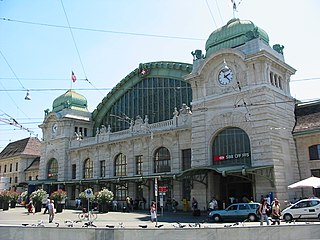
Basel SBB railway station is the central railway station in the city of Basel, Switzerland. Opened in 1854, and completely rebuilt in 1900–1907, it is Europe's busiest international border station. Basel SBB is owned by the Swiss Federal Railways (SBB CFF FFS). The other major railway station is Basel Badischer Bahnhof, operated by the German railway company Deutsche Bahn, on the north side of the Rhine from the city centre.

The Bière–Apples–Morges Railway (BAM) or Chemin de fer Bière-Apples-Morges, located in Switzerland, is a 1,000 mmmetre gauge railway with a total length of almost 30 kilometres (19 mi) which links the towns in its name and from a junction at Apples to the village of L’Isle. The company was renamed to Transports de la région Morges-Bière-Cossonay (MBC) to express its other activities, mainly in local and regional bus services. Furthermore the Funiculaire Cossonay–Gare–Ville is part of MBC since 2010, Before, MBC was contracted to operate it.
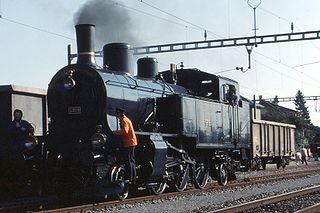
For more than a century, the Swiss locomotive, multiple unit, motor coach and railcar classification system, in either its original or updated forms, has been used to name and classify the rolling stock operated on the railways of Switzerland. It started out as a uniform system for the classification and naming of all rolling stock, powered and unpowered, but had been replaced and amended by the UIC classification of goods wagons.
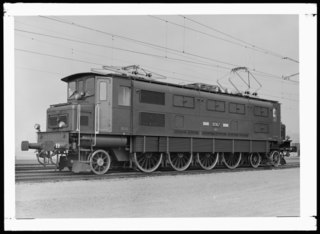
The Ae 4/7 was a universal locomotive of the Swiss Federal Railways, employing the so-called Buchli drive.
The Jura–Simplon Railways (JS), was a railway company that was formed in 1890. It was nationalised in 1903 as the largest railway company in Switzerland and integrated into the Swiss Federal Railways (SBB).

The Ee 922 is a class of 21 electric shunting locomotives built since 2009 by Stadler Rail for Swiss Federal Railways.
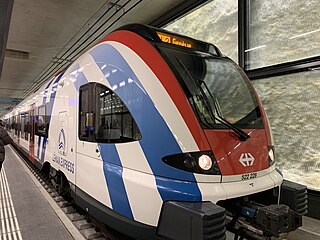
The Léman Express is a commuter rail network for the transborder agglomeration of Grand Genève in west Switzerland and the French Alps. Six lines serve Swiss and French towns along 230 km of railway.

The SBB-CFF-FFS Ae 8/14 is a class of electric locomotives built for Swiss Federal Railways to be used on the Gotthard railway. Only three prototype engines were built between 1931 and 1938, each of them in a different design.

The Simplon Railway is a line that links Lausanne in Switzerland and Domodossola in Italy, via Brig. The 20 km (12 mi)-long Simplon Tunnel is a major part of it. The line between Lausanne and Vallorbe is sometimes considered to form part of the line, making it 233 km (145 mi) long.

Rigid-framed electric locomotives were some of the first generations of electric locomotive design. When these began the traction motors of these early locomotives, particularly with AC motors, were too large and heavy to be mounted directly to the axles and so were carried on the frame. One of the initial simplest wheel arrangements for a mainline electric locomotive, from around 1900, was the 1′C1′ arrangement, in UIC classification.

The BB 20100 was a small class of two groups of two dual voltage electric locomotives of SNCF intended for cross-border traffic between France, Switzerland and Germany.




















